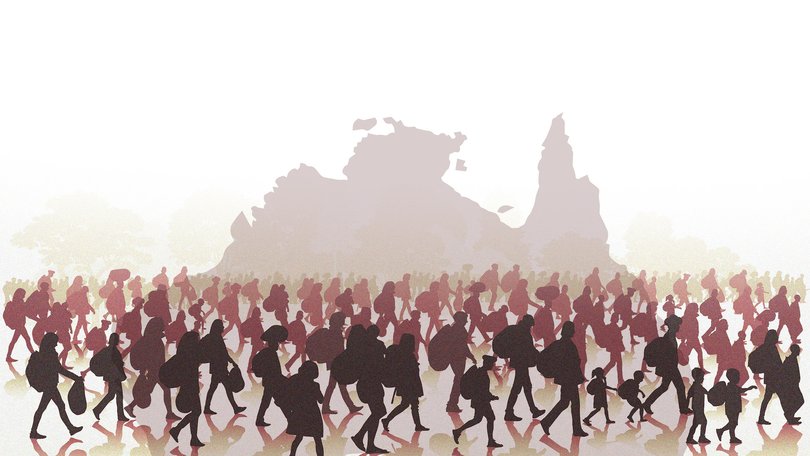JENI O’DOWD: Until overstayers are counted Australia’s entire immigration debate is built on fiction

At the risk of being accused again of fuelling the “rabid right”, here’s something no one wants to touch: the tens of thousands of people who come here legally and never leave.
They overstay their visas, melt into the suburbs and, for most Australians, vanish from the statistics.
As of June 2024, about 75,400 people were living in Australia unlawfully. Only a couple of hundred were in detention. That’s the population of a city like Shepparton, Wagga, or Bunbury quietly living here, uncounted.
Sign up to The Nightly's newsletters.
Get the first look at the digital newspaper, curated daily stories and breaking headlines delivered to your inbox.
By continuing you agree to our Terms and Privacy Policy.Yet beyond those numbers, overstayers are almost never mentioned in the arguments about immigration.
This isn’t some new problem, overstayers have been living in Australia for decades
While Liberal frontbencher Jacinta Nampijinpa Price spent last week courting outrage with her clumsy claim about Indian migrants — and Opposition Leader Sussan Ley spent the weekend mopping up the fallout with repeated apologies — this issue is ignored.
Politicians fight over the optics of who comes in and how they vote, but no one wants to talk about the 75,000 people living here illegally.
Home Affairs surveys suggest that about 30 per cent of overstayers arrive on tourist visas and another 20 per cent on student visas.
This means that almost half slipped through the cracks after entering the country lawfully. Some came seeking work or sponsorship. Others landed as tourists, bought time with a student visa, even lodged protection claims, and then simply never left.
Meanwhile, the rest of the visa system keeps ballooning. By April there were more than 720,000 student visa holders in Australia, up from about 608,000 just 10 months earlier.
That’s an extra 110,000 people in less than a year.
By contrast, permanent migration has been officially capped at 185,000 for the 2025–26 financial year, the same as the year before. That 185,000 isn’t just skilled workers. About 48,000 of those places are for family reunion visas, primarily for partners — a much broader category than the headlines about the much-needed tradies and tech workers.
Home Affairs Minister Tony Burke said the permanent migration figure was the result of “consultations with States and Territories” and stressed that the focus remained on skilled migration.
Prime Minister Anthony Albanese has repeatedly said net overseas migration has dropped since the post-COVID spike and is “substantially less than 500,000”.
He also warned against “hateful rhetoric” infecting the debate.
But the figures tell a different story. As of 2023–24, net overseas migration stood at roughly 446,000 people, only 54,000 fewer than the record 536,000 in 2022–23. This is hardly a dramatic fall.
The Government projects it will tumble further to about 260,000 in 2025–26, but those forecasts assume hundreds of thousands of temporary visa holders will dutifully pack up and leave on time. History shows many don’t.
What’s the point of boasting about caps, cuts and targets if tens of thousands of overstayers aren’t counted in the first place?
Politicians prefer the headlines about international students or net migration forecasts. Boats make for dramatic backdrops. Overstayers are politically inconvenient.
And yet, they matter. Every overstayer is another person seeking housing in a market already stretched to its breaking point. Another patient in a hospital queue. Another child in an overcrowded classroom. They’re invisible in Canberra, but very visible in the suburbs.
This isn’t some new problem either. Overstayers have been living in Australia for decades.
Back in the 1990s, governments knew tens of thousands were slipping through the net, but it was easier to fixate on boat arrivals. Boats made the nightly news. Planes didn’t. That’s still true today. We’ve built an entire political culture around stopping boats, yet the far bigger issue of overstayers has been left to fester.
Readers are right to be angry. Last week, when I wrote that immigration numbers were too high, many of you agreed. One reader, Peter R, didn’t, and that’s fine. He argued that migrants power industries from aged care to hospitality. He’s right: many do. But where I part ways with Peter is in his dismissal of legitimate concerns as the territory of the “rabid right”.
Ordinary Australians who can’t buy a home, who can’t afford fruit and vegetables for their kids or who crawl through gridlocked traffic aren’t extremists. They’re simply asking whether the country can cope. And they’re sick of being sneered at for even raising the question.
This is not about race. It’s about sustainability. It’s about whether a nation already straining at the seams can absorb more people without breaking.
As many of you said, governments only start listening when an election looms. In between, voices are ignored.
The growing chorus about housing, infrastructure and migration pressure has been getting louder for years.
Labor doesn’t want to be seen as heavy-handed. The Coalition prefers to keep playing the border security card. Both sides are guilty of ducking a significant part of the issue. Meanwhile, the invisible city of overstayers grows bigger every year.
Until overstayers are counted, until their impact is acknowledged and addressed, the entire debate is built on fiction.
Australians are not fools. We see the gap between official lines and lived reality. We know when numbers don’t add up. And no amount of spin about caps and cuts will silence those frustrations.
